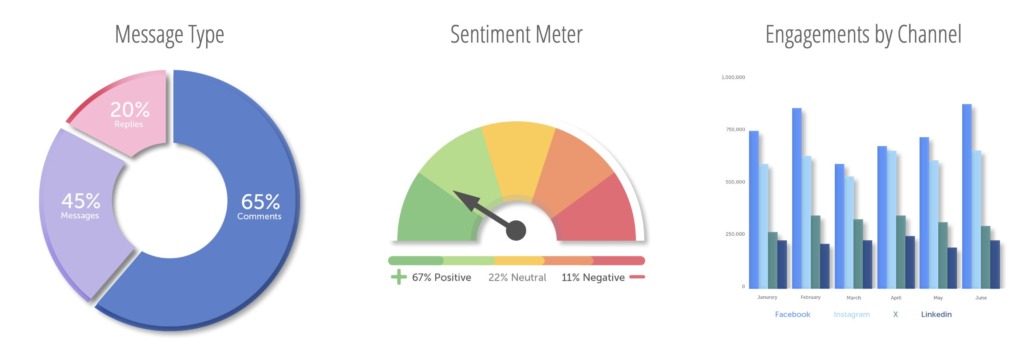The Importance of Measuring Social Media Sentiment
In today’s digital age, businesses use social media as a platform and crucial tool for understanding customer sentiment. Social media sentiment analysis, which involves gathering customer perceptions of a brand, product, or service online, is a metric that helps brands shape their online environment and compare themselves in the eyes of the consumer and the competition. Let’s investigate how measuring social media sentiment can significantly influence your brand’s perception.
Brand Messaging
Social media sentiment analysis provides immediate access to user interactions. This allows your brand to craft messages they are more likely to resonate with and alter strategy according to the content types consumers prefer. As a brand evolves and introduces new products, how your brand is perceived is bound to change. By analyzing these sentiments consistently, you can stay up to date to have a more effective campaign and more vital brand awareness.

Positive, Negative, and Neutral
Sentiment analysis should be at the forefront of every content strategy by a brand. Understanding how your audience feels towards you improves customer engagement and interaction. Social media sentiment dives into the emotions behind these online interactions. Customers turn to social media platforms as the first place to express these emotions through posts, comments, and likes. How your brand responds to these will make or break your brand.
Seeing a surge of praise on social media indicates that your brand is resonating well with your target audience. Acknowledging these positive comments with thanks can strengthen your customer relationship and show that you value their support and feedback. Some positive terms you can look for might include:
- – Helpful
- – Quality
- – Love
- – Thanks
- – Amazing
- – Consistent

Engaging with positive mentions fosters a stronger connection between your brand and audience, reinforcing customer satisfaction and loyalty.
On the other hand, an influx of negative comments and complaints alerts brands of problems with a product or service they should investigate immediately. Monitoring these sentiments is crucial for understanding audience needs and how your brand should alter its strategy. Actively engaging with the audience, especially with negative comments, can improve your brand’s reputation, showing the audience you care about their experience and are firmly committed to improving your services. Some negative terms to look out for might include:
- – Upset
- – Disappointed
- – Mad
- – Hate
- – Angry

For example, Target recently responded to customer feedback on social media by adjusting their online shopping experience, showing they are listening and making changes based on customer concerns. This responsiveness demonstrates a commitment to improvement, turning potentially negative experiences into opportunities to build customer loyalty.
Social Media sentiment analysis helps you control your reputation. Discussions are constantly happening online; you can control and adjust the narrative better when you have a detailed sentiment analysis, ensuring you’re addressing it head-on.
How To Measure Brand Sentiment
Simply looking at social media mentions will not give you the richest look at consumers’ inside conversations regarding your brand’s presence. Understanding social media sentiment helps strengthen your brand, giving you a strategic advantage by identifying customer needs, enhancing products, and making more informed decisions.
- Keyword Analysis: Tools like MonkeyLearn and Sprout Social can track specific words and phrases and determine whether they were used in a positive, negative, or neutral context. They analyze social media platforms such as X, Instagram, Yelp, and Google Reviews for a saturated coverage of your brand.
- Natural Language Processing (NLP): NLP is an artificial intelligence software, a resource used now more than ever for measuring analytics. It’s an excellent option for brands looking to analyze the tone of social media content to categorize it into different emotional responses. NLP can summarize information, answer questions, and even conduct conversations.
- Surveys and Polls: Beyond examining engagement manually and monitoring specific trends, directly asking the audience for feedback through surveys or polls on social media can allow immediate feedback on your audience’s attitudes toward your brand, products, and content.

Measuring social media sentiment is essential for maintaining a positive brand image and deepening customer relationships. By actively monitoring and responding to customer feedback—whether positive or negative—your brand can adapt its strategies, improve products, and build stronger connections with its audience, ultimately leading to more long-term success. At Bright Age, we understand the power of social media sentiment in shaping brand perception. By leveraging our expertise in digital marketing, we help brands actively monitor and respond to customer sentiment in real time, ensuring your brand stays connected to its audience, enhances customer loyalty, and drives long-term success in the ever-evolving digital landscape.





